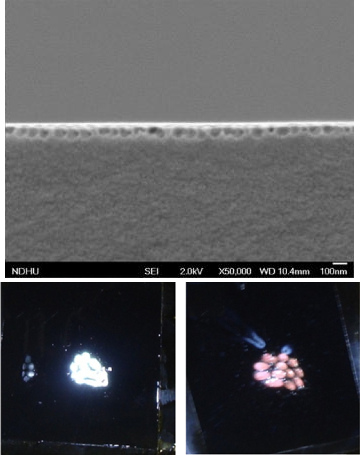
A CREOL team developed a nanostructured coating (top), based on moth’s eyes, that, compared with conventional surfaces under white-light illumination (bottom left), cuts reflections and allows details to shine through (bottom right). The team believes the new film could substantially improve readability of mobile devices in sunlight—and that it’s ready out of the box for next-generation foldable and flexible screens. [Images: G. Tan et al., Optica, doi: 10.1364/OPTICA.4.000678]
From time to time on this site, we’ve reported on new optical devices and techniques that take their inspiration from nature—everything from structural coloration modeled on beetle shells to a curved CMOS sensor whose shape tracks that of the human retina. Now, researchers at the College of Optics and Photonics, University of Central Florida (CREOL), USA, have drawn on another natural example—the eyes of moths—to create a flexible, broadband antireflection film that can cut luminous reflectance to less than 0.23 percent (Optica, doi: 10.1364/OPTICA.4.000678).
The team believes that its new antireflection coating, which is also scratch-resistant and can be made self-cleaning, could substantially improve the readability of mobile phones and tablets in direct sunlight. And the film’s flexibility and toughness could prove particularly useful for the next-gen foldable and flexible screens expected to emerge in coming years.
Seeing the screen in the sunlight
Better sunlight visibility has long been something of a holy grail for mobile devices, and the approaches thus far involve some trade-offs. Most smartphones and tablets at present simply detect the ambient light and pump up the screen’s brightness when the device is in the sun, to push the screen image past the surface reflections. The strategy works—but it burns through a lot of battery power. And an alternative approach, multilayer antireflection coatings, often have had wavelength and directional dependencies that have made them a poor fit with consumer applications such as smartphones.
For the past decade or so, researchers have looked at the properties of moth eyes as an alternative model for the battle against reflections. Evolution has tuned the nanostructures in these insects’ eyes to minimize reflections, which helps them see in the dark and also makes it less likely to attract the attention of predators looking for a quick snack. The moth-eye strategy has already found some success in optical-technology niches, such as reflection-reducing coatings for solar cells and some display applications.
Nanosphere stamp
The CREOL team, led by OSA Fellow Shin-Tson Wu, wanted to see if they could create a moth’s-eye film robust enough for use on smartphones—and flexible enough to adapt to the flexible and foldable digital displays that are set to emerge in coming years. To do so, they spin-coated a layer of SiO2 nanoparticles, each 100 nm in diameter, onto a hydrophilic glass surface to create a reusable mold with the appropriate characteristics. They then pressure-stamped the mold pattern into a hard-coating polymer-cellulose thin film and cured the film pattern with UV light. A quick hydrofluoric acid bath etched off any remaining nanoparticle residues, leaving only the moth’s-eye structure on the film.
The team found that the moth’s-eye film sported a transmittance of greater than 95 percent, and luminous reflectance of less than 0.23 percent—more than an order of magnitude below the 4.4 percent reflectance of a typical iPhone. The researchers also put the film through a barrage of material tests, which revealed good scratch resistance and bendability—strong characteristics, the team suggests, for next-generation bendable and foldable screens. They even found that they could make the film “self-cleaning” by coating the surface with a thin hydrophobic layer.
Given the film’s combination of good material properties and an ability to minimize reflections across a wide wavelength band, the team believes that the coating could “find widespread applications for sunlight-readable flexible and curved display devices.” The next steps, according to the researchers, are to tweak the formula to improve the material properties still further—and, through numerical modeling, to optimize the optical details of the moth’s-eye surface.
